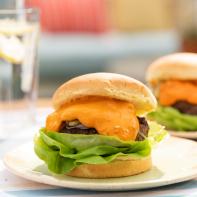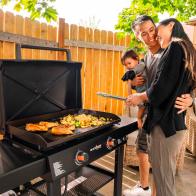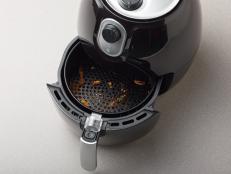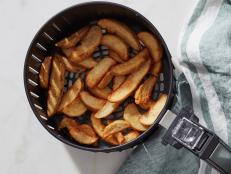How Safe Is It To Order Takeout Right Now?
Here are steps you can take to feel more comfortable ordering in.

shironosov/Getty Images
Ordering food — whether as delivery or take-out — is a great way to take a pause from cooking and support your favorite restaurants. It’s natural to be concerned about the safety of ordering in, especially during a time when it's especially important to stay healthy and protect yourself and others. We interviewed top food safety experts to find out how you can stay safe when ordering in or taking out food from local restaurants, and what restaurants are doing to keep your food safe, too.
What Are the Risks of Ordering Takeout?
According to the Food and Drug Administration (FDA), there have been no links to COVID-19 being transmitted through food.
The virus is spread from human-to-human contact through droplets when an infected person coughs or sneezes. These droplets can end up in the mouths, eyes or noses of people nearby or inhaled into the lungs. The best way to prevent the spread of the virus is to practice social distancing and stay at least six feet apart. When you order takeout or delivery, there is the possibility of human contact. However, there are steps you can take minimize your risk of contracting COVID-19.
If you're thinking, but what about food packaging: “Health authorities affirm that there is no evidence that food or food packaging is causing the spread of coronavirus,” explains Tamika Sims, PhD, Director of Food Technology Communications at the International Food Information Council (IFIC). “The risk is of contracting the virus from a food item is likely very small, but should not be counted as impossible.” Sims also explains that research has found that the coronavirus can survive up to 24 hours on cardboard and up to two to three days on plastic and stainless steel after contact. Thus, it’s important to wash or sanitize your hands after handling packages.
What Restaurants Are Doing to Keep Your Food Safe
Having food and meals delivered to your home or set out for curbside pickup, or just popping in to pick up a to-go order does minimize person-to-person contact. This is helpful in order to decrease germ and sickness transfer. According to Sims, restaurants are doing their part too by practicing food-handling hygiene protocols to avoid transferring germs year-round. These practices include requiring employees not to report to work while sick, to keep hands clean while handling food, to wear protective gear while handling food (like aprons, gloves and hairnets), and to keep all surfaces that come into contact with food clean. Sims also notes that many restaurants, stores and delivery services have ramped up these protocols to further combat COVID-19.

TriggerPhoto/Getty Images
How to Minimize Your Risk of Illness
Even though the risk is relatively small, there are numerous things you can do to minimize your risk of exposure when ordering delivery or takeout.
- Call the restaurant: Larry Lynch, SVP of Science and Industry at National Restaurant Association, recommends talking to the restaurant and asking them what they are doing in order to protect you from contracting the virus and to increase your comfort level with ordering in. You can ask about hand-washing rules, if employees are wearing face coverings, how the packaging is being delivered, and what is being done when employees are feeling ill. The Centers for Disease Control (CDC) has recently recommended that all restaurant employees wear face coverings, and many local officials now require it. This provides an additional layer of protection in a person who is pre-symptomatic. You can also check out the restaurant's website and social media channels, as some places are posting their protocols there.
- Request pre-packaged plasticware: We usually forgo disposable silverware in favor of our own clean utensils, but if you do require disposable forks and knives, Lynch suggests asking the restaurant to use pre-packaged plasticware that needs to be unwrapped.
- Wash hands often: Wash your hands when you come home from picking up food, when you are done handling food delivery packages and bags, and before you eat. If you get your meals delivered, unbag and unwrap your food and then wash your hands before you begin eating (with clean plates and cutlery). It is important to keep your hands as clean as you can at all times and avoid touching your face (which holds several potential entry points for germs — eyes, nose and mouth). Not touching your face at all can be difficult, so it is best to be mindful of keeping your hands clean before you eat and even after you eat.
- It’s not recommended to sanitize food packages: Sims says, “It is not advisable to try to sanitize food packages before opening them, because doing so may transfer chemical residues to your food.” This is a problem because “if cleaning products are ingested, even in small amounts, they can make you sick.” Instead, Sims recommends washing your hands when you’re done handling food delivery packages and bags before you eat. Lynch says that if it makes you feel better, you can choose to wipe down food packaging, but it isn’t necessary. He does say avoid washing food with soap, detergent or bleach as they can be toxic.
- Sanitize your kitchen: Sims recommends keeping your kitchen as clean as possible, including sanitizing countertops, handles (refrigerator doors, cabinet handles, pantry handles, etc.), knobs, refrigerator shelves and other areas that come into contact with food. The Environmental Protection Agency (EPA) has a list of effective household disinfectants that can be used against coronavirus.
- Minimize cash exchanges: Opt to leave a tip on the online app through your credit card or other form of digital payment. “Many of us don’t think about it, but money has never been sterile or clean (it exchanges hands very often so carries many germs),” says Sims. If you handle money, be sure to clean your hands before you eat. Your wallet, credit card and cell phone all carry germs, so always wash your hands after handling. If you do need to leave cash for the meal, then leave it in an envelope for the delivery person and always wash your hands after touching cash.
- Carry your own pen: Many restaurants don’t make you sign receipts, but do bring your own pen just in case.
Toby Amidor, MS, RD, CDN, is a registered dietitian and consultant who specializes in food safety and culinary nutrition. She is the author of The Greek Yogurt Kitchen: More Than 130 Delicious, Healthy Recipes for Every Meal of the Day.
*This article was written and/or reviewed by an independent registered dietitian nutritionist.
Related Content:

































